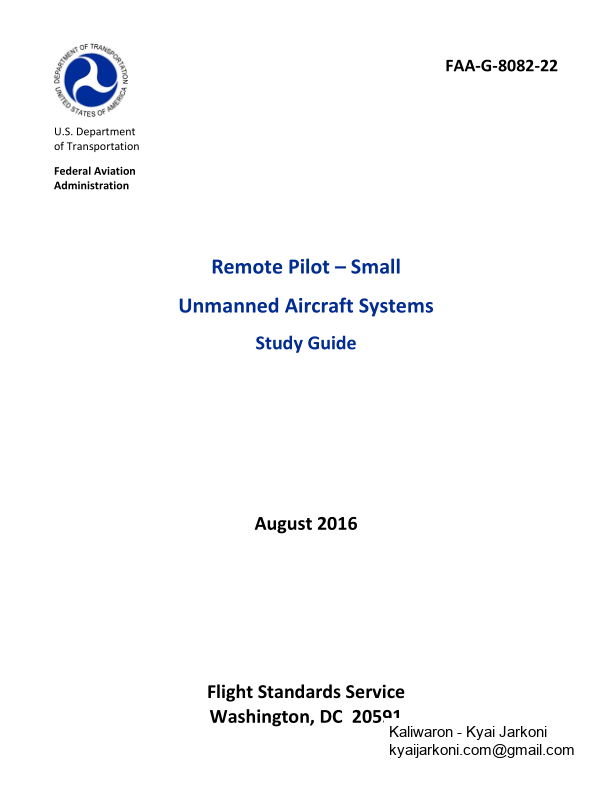In most cases, a remote pilot will not need ATC authorization to operate in congestion of sightseeing aircraft above an incident or event, that may.
41 KB – 88 Pages
PAGE – 3 ============
Remote Pilot ΠSmall Unmanned Aircraft Systems Study Guide i Preface The Federal Aviation Administration (FAA) has published the Remote Pilot ΠSmall Unmanned Aircraft Systems (sUAS) Study Guide to communicate the knowledge areas you need to study to prepare to take the Remote Pilot Certificate with an sUAS rating airman knowledge test . This Remote Pilot ΠSmall Unmanned Aircraft Systems Study Guide is available for download from faa.gov . Please send comments regarding this document to [email protected] .
PAGE – 5 ============
Remote Pilot ΠSmall Unmanned Aircraft Systems Study Guide iii Table of Contents Introduction .. .. .. 1 Obtaining Assistance from the Federal Aviation Administration (FAA) . 1 FAA Reference Material . 1 Chapter 1: Applicable Regulations .. .. .. 3 Chapter 2: Airspace Classification, Operating Requirements, and Flight Restrictions .. 5 Introduction .. 5 Controlled Airspace .. 5 Uncontroll ed Airspace . 6 Special Use Airspace . 6 Other Airspace Areas 9 Air Traffic Control and the National Airspace System .. 12 Visual Flight Rules (VFR) Terms & Symbols 12 Notices to Airmen (NOTAMs) 13 Chapter 3a: Aviation Weather Sources .. .. .. 15 Introduction 15 Surface Aviation Weather Observations . 15 Aviation Weather Reports .. 15 Aviation Forecasts .. 18 Convective Significant Meteorological Information (WST) 19 Chapter 3b: Effects of Weather on Small Unmanned Aircraft Performance .. 21 Introduction 21 Density Altitude 21 Performance .. 22 Measurement of Atmosphere Pressure .. 22 Effect of Obstructions on Wind 23 Low -Level Wind S hear .. 23 Atmospheric Stability 24 Temperature/Dew Point Relationship . 25 Clouds 25 Fronts . 26 Mountain Flying 26 Structural Icing .. 26 Thunderstorm Life Cycle .. 26 Ceiling 28 Visibility 28 Chapter 4: Small Unmanned Aircraft Loading .. .. . 29
PAGE – 6 ============
Remote Pilot ΠSmall Unmanned Aircraft Systems Study Guide iv Introduction 29 Weight .. 29 Stability . 30 Load Factors 30 Weight and Balance 32 Chapter 5: Emergency Procedures .. .. 35 Introduction 35 Inflight Emergency .. 35 Chapter 6: Crew Resource Management .. .. .. 37 Chapter 7: Radio Communi cation Procedures .. .. 39 Introduction 39 Understanding Proper Radio Procedures 39 Traffic Advisory Practices at Airports without Operating Control Towers 39 Chapter 8: Determining the Performance of Sm all Unmanned Aircraft .. . 43 Introduction 43 Effect of Temperature on Density .. 43 Effect of Humidity (Moisture) on Density .. 43 Chapter 9: Physiological Factors (Including Drugs and Alcohol) Affecting Pilot Performance .. .. .. 45 Introduction 45 Physiological/Medical Factors that Affect Pilot Performance . 45 Vision and Flight .. 50 Chapter 10: Aeronautical Decision -Making and Judgment .. .. 51 Introduction 51 History of ADM . 51 Risk Management 52 Crew Resource Management (CRM) and Single -Pilot Resource Management .. 53 Hazard and Risk 53 Human Factors .. 56 The Decision -Making Process 57 Decision -Making in a Dynamic Environment 59 Situational Awareness .. 63 Chapte r 11: Airport Operations .. .. . 65 Introduction 65 Types of Airports . 65 Sources fo r Airport Data .. 65 Latitude and Longitude (Meridians and Parallels) . 68
PAGE – 9 ============
Remote Pilot Œ Small Unmanned Aircraft Systems Study Guide 1 Introduction The information in this study guide was arranged according to the knowledge areas that are covered on the airman knowledge test for a Remote Pilot Certificate with a Small Unmanned Aircraft Systems Rating as required by Title 14 of the Code of Federal Regulations ( 14 CFR ) part 107, section 107.73(a) . The knowledge areas are as follows: 1. Applicable regulations relating to small unmanned aircraft system rating privileges, limitations, and flight operation; 2. Airspace classification, operating requirements, and flight restrictions affecting small unmanned aircraft operation; 3. Aviation weather sources and effects of weather on small unmanned aircraft performance; 4. Small unmanned aircraft loading; 5. Emergency procedures; 6. Crew resource management; 7. Radio communication procedures; 8. Determining the per formance of small unmanned aircraft; 9. Physiological effects of drugs and alcohol; 10. Aeronautical decision -making and judgment; 11. Airport operations; and 12. Maintenance and preflight inspection procedures. Obtaining Assistance from the Federal Aviation Administrati on ( FAA ) Information can be obtained from the FAA by phone, Internet/e -mail, or mail. To talk to the FAA toll -free 24 hours a day, call 1 -866 -TELL- FAA (1 -866 -835 -5322). To visit the FAA™s website, go to www.faa.gov. Individuals can also e -mail an FAA representative at a local FSDO office by accessing the staff e -mail address available via the fiContact FAAfl link at the bottom of the FAA home page. Letters can be sent to: Federal Aviation Administration 800 Independence Ave, SW Washington, DC 20591 FAA Reference M aterial The FAA provides a variety of important reference material for the student, as well as the advanced civil aviation pilot. In addition to the regulations provided online by the FAA, several other publications are available to the user. Almost all reference material is available online at www.faa.gov in downloadable format. Commercial aviation publishers also provide published and online reference material to further aid the aviation pilot. Aeronautical Information Manual (AIM) Handbooks Advisory Circulars (ACs) Airman Certification Standards 14 CFR part 107
41 KB – 88 Pages
